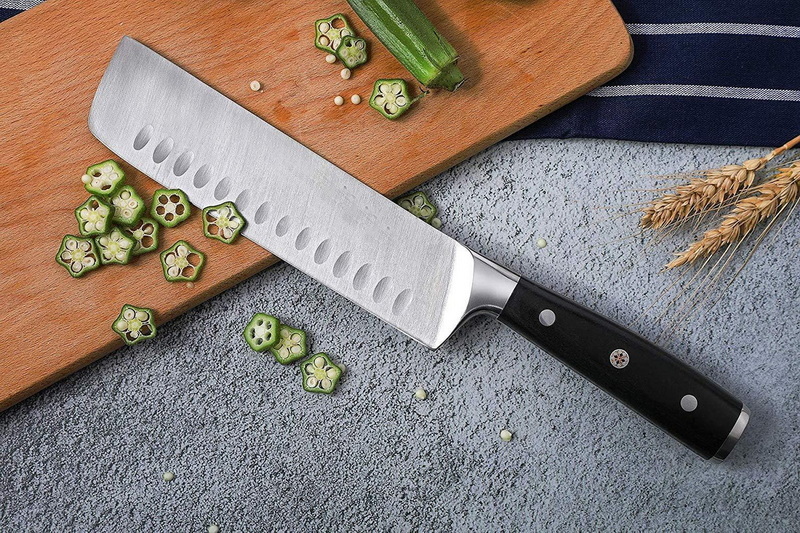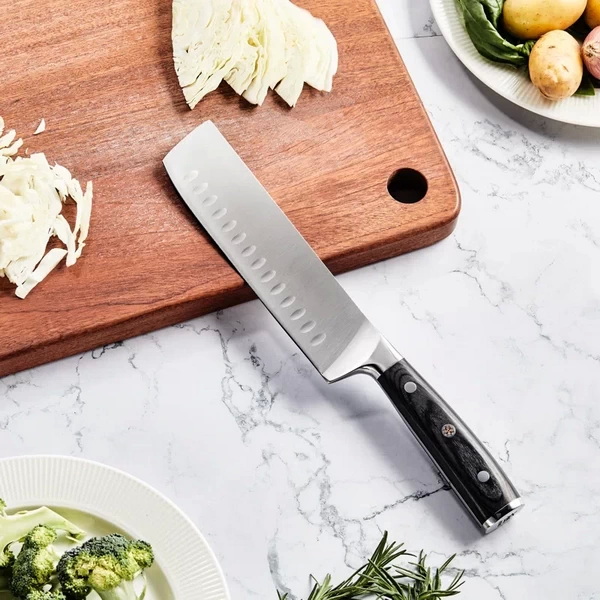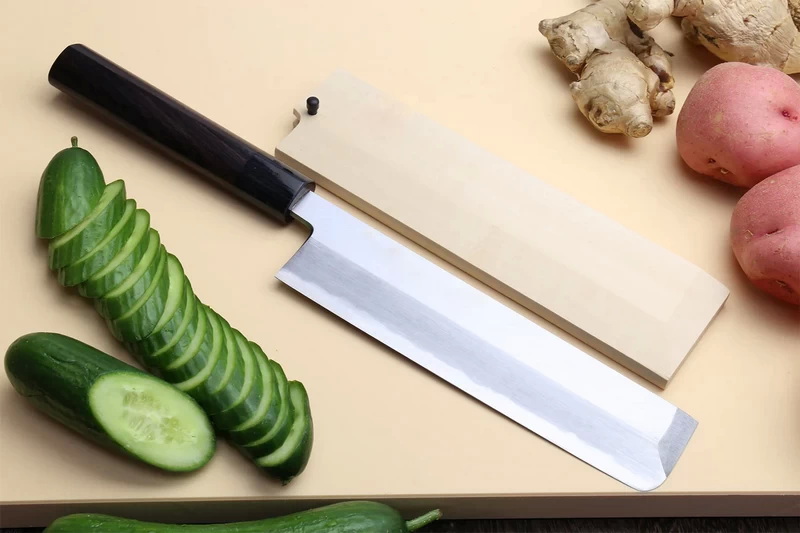









Content Menu
● Why Use a Vegetable Knife? Key Benefits
>> 1. Precision and Uniformity in Cuts
>> 2. Efficiency and Speed in Food Preparation
>> 3. Versatility for Various Vegetable Tasks
>> 5. Preservation of Vegetable Quality
● How to Use a Vegetable Knife Effectively
● Types of Vegetable Knives and Their Uses
● Practical Vegetable Cutting Techniques with a Vegetable Knife
● Additional Advantages of Using a Vegetable Knife
>> Enhancing Culinary Creativity
>> Improving Kitchen Ergonomics
>> Ideal for Small and Delicate Vegetables
>> Complementing Other Kitchen Knives
● Choosing the Right Vegetable Knife for Your Kitchen
● Care and Maintenance Tips for Your Vegetable Knife
● FAQ
>> 1. What makes a vegetable knife different from a chef's knife?
>> 2. Can I use a vegetable knife for fruits?
>> 3. How do I choose the right vegetable knife?
>> 4. Is a Nakiri knife suitable for beginners?
>> 5. How should I maintain my vegetable knife?
Vegetable knives are specialized kitchen tools designed specifically for preparing vegetables and fruits with precision, efficiency, and ease. Unlike general-purpose knives, vegetable knives have unique features that make them indispensable for anyone who values quality and speed in the kitchen. This article explores why using a vegetable knife can transform your cooking experience, detailing its design, advantages, techniques, and tips for choosing the right one. We will also include practical guidance on how to use a vegetable knife effectively, supported by visual explanations and videos to enhance your skills.

A vegetable knife is a kitchen knife primarily designed for cutting, peeling, and preparing vegetables and fruits. It is characterized by a sharp, flat, and often broad blade, usually shorter than a chef's knife, with a straight edge that allows clean, even cuts without the rocking motion typical of other knives. This design is ideal for chopping, slicing, dicing, and peeling vegetables with precision and minimal waste.
The Nakiri knife, a traditional Japanese vegetable knife, is one of the most popular types. It features a straight, rectangular blade with a double bevel, making it versatile and user-friendly for both home cooks and professionals. Other variants include the Usuba knife, which is single-beveled and used for more delicate, decorative cuts but requires more skill to handle.
One of the most significant advantages of a vegetable knife is its ability to produce precise, uniform cuts. Whether you are julienning carrots, dicing onions, or slicing cucumbers, the flat, sharp blade ensures clean cuts that maintain the integrity of the vegetable. Uniform cuts are essential not only for aesthetic presentation but also for even cooking, enhancing the texture and flavor of dishes.
Vegetable knives reduce preparation time dramatically. Their design allows you to chop, dice, and slice vegetables quickly without the need for complex cutting motions. The flat blade contacts the cutting board fully, enabling efficient chopping and dicing. The broad blade also allows for easy scooping and transferring of chopped vegetables from the board to the pot or pan, streamlining the cooking process.
Beyond chopping, vegetable knives excel at peeling and shaping vegetables. Specialized peeling knives, a variant of vegetable knives, have curved blades perfect for removing thin layers of skin from fruits and vegetables with minimal waste. Vegetable knives are also suited for a range of Japanese culinary cuts such as wa-giri (round slices), hangetsu-giri (half-moon slices), and kakugiri (cube cuts), allowing for creative and professional food presentation.
Using a sharp, specialized vegetable knife is safer than using a dull, general-purpose knife. A sharp blade requires less force, reducing the risk of slipping and injury. Additionally, many vegetable knives feature ergonomic handles that provide a secure grip, even when wet, enhancing control and comfort during prolonged use.
The thin, flat blade of vegetable knives like the Nakiri prevents bruising and crushing of delicate vegetables. This is crucial because bruising releases enzymes that can oxidize and alter the flavor of the ingredients. A clean cut preserves the vegetable's texture and taste, contributing to a better culinary outcome.
Mastering the use of a vegetable knife involves understanding proper grip, cutting techniques, and safety measures. Here is a step-by-step guide:
- Use a stable, non-slip cutting board.
- Ensure your vegetable knife is sharp.
- Wash and peel vegetables as needed.
- Use the pinch grip: hold the blade between your thumb and the side of your index finger for control.
- Curl the fingers of your guide hand inward, using knuckles as a cutting guide to prevent injury.
- For chopping and dicing: use a push-forward and pull-back motion with the flat blade gliding smoothly through the vegetable.
- For julienning: cut vegetables into even planks, stack them, then slice into thin strips.
- For diagonal cuts: slice at a 45-degree angle for increased surface area and visual appeal.
- For peeling: use a small peeling knife with a curved blade to remove thin layers of skin.
- Use the broad blade to scoop chopped vegetables and transfer them easily to bowls or pans without additional tools.
| Knife Type | Blade Characteristics | Best For | Skill Level |
|---|---|---|---|
| Nakiri | Flat, rectangular, double-beveled | General vegetable chopping, slicing, dicing | Beginner to Expert |
| Usuba | Flat, rectangular, single-beveled | Precise, decorative vegetable cuts | Expert |
| Peeling Knife | Small, curved blade | Peeling and shaping round vegetables | Beginner to Expert |
- Julienne Cut: Thin, matchstick-like strips ideal for salads and garnishes.
- Brunoise Cut: Fine dice made by further cutting julienne strips.
- Wa-giri (Round Slices): Circular slices for carrots and cucumbers.
- Hangetsu-giri (Half-Moon Slices): Half-moon shaped slices for soups and stews.
- Kakugiri (Cube Cuts): Diced cubes after slicing into strips.
These cuts enhance both the texture and presentation of dishes and are achievable with practice using a vegetable knife.

A vegetable knife opens up new possibilities for culinary creativity. Because it allows for precise and delicate cuts, you can experiment with intricate garnishes and decorative vegetable presentations that elevate the visual appeal of your dishes. This is especially valuable in cuisines where presentation is as important as flavor, such as Japanese and French cooking.
The sharp, thin blade of a vegetable knife enables you to peel and trim vegetables with minimal waste. Unlike bulkier knives that remove thick layers of skin or flesh, a vegetable knife allows for thin, controlled cuts that maximize the edible portions of your ingredients, saving money and reducing waste.
Many vegetable knives are designed with ergonomics in mind, featuring balanced weight distribution and comfortable handles. This reduces hand fatigue during extended food preparation sessions, making it easier to maintain consistent cutting quality and reducing the risk of repetitive strain injuries.
Vegetable knives excel when working with small or delicate vegetables such as cherry tomatoes, radishes, or herbs. Their precision and control allow for gentle handling, preventing bruising and preserving the natural texture and flavor of these ingredients.
While a vegetable knife is specialized for vegetables, it complements other knives in your kitchen arsenal, such as chef's knives, paring knives, and boning knives. Having a dedicated vegetable knife means you can reserve your chef's knife for meat and general tasks, prolonging its sharpness and effectiveness.
When selecting a vegetable knife, consider the following factors to ensure it meets your cooking needs:
- Blade Material: High-carbon stainless steel offers a good balance of sharpness, durability, and corrosion resistance.
- Blade Length: Typically ranges from 5 to 7 inches; choose a length that feels comfortable and manageable.
- Handle Design: Look for ergonomic handles made from durable materials like wood, resin, or composite for a secure grip.
- Weight and Balance: The knife should feel balanced in your hand, neither too heavy nor too light, to facilitate smooth cutting motions.
- Maintenance Requirements: Some knives require more care, such as hand washing and regular sharpening, so choose one that fits your maintenance preferences.
To keep your vegetable knife in optimal condition:
- Sharpen regularly using a whetstone or a professional sharpening service.
- Hone the blade frequently with a honing rod to maintain edge alignment.
- Always hand wash your knife with mild detergent and dry immediately to prevent rust and corrosion.
- Store the knife in a knife block, magnetic strip, or protective sheath to avoid dulling the blade.
- Avoid cutting on hard surfaces like glass or granite which can damage the blade edge.
Using a vegetable knife offers numerous advantages that elevate your cooking experience. Its specialized design provides precision, efficiency, and versatility in vegetable preparation, allowing you to create beautiful, evenly cut ingredients that cook uniformly and look professional. Whether you choose a Nakiri for its user-friendly double bevel or an Usuba for intricate cuts, mastering the vegetable knife can transform your kitchen skills. With proper technique and maintenance, this essential tool will make your food preparation faster, safer, and more enjoyable.

A vegetable knife typically has a flat, straight edge and a broader, shorter blade designed specifically for cutting vegetables cleanly and precisely without rocking motions, unlike the curved blade of a chef's knife which is more versatile but less specialized for vegetables.
Yes, vegetable knives are excellent for fruits as well, especially for peeling and slicing. Their sharp, precise blades allow you to remove thin layers of skin and make clean cuts without crushing soft fruits.
Consider blade type (double-beveled for ease of use, single-beveled for precision), blade size (comfort and vegetable size), handle comfort (ergonomic grip), and material (high-carbon stainless steel for durability and sharpness).
Yes, the Nakiri knife with its double-beveled, straight blade is user-friendly and ideal for both beginners and experienced cooks for general vegetable preparation.
Sharpen regularly with a whetstone, hone frequently, hand wash and dry immediately after use, and store safely to prevent damage and rust.